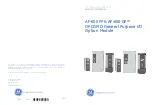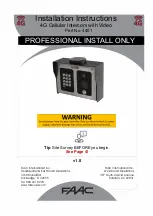
9
Troubleshooting
If the intercom system does not operate as expected, check the following items:
• Check for power at the intercom and confirm that the fuse is not blown or
the circuit breaker is not tripped.
• Confirm that a dedicated ground is used for the intercom power and not a
chassis ground.
• Check headset controls.
Alternator whine and other distracting noises
• Connect both the intercom and radio to the cleanest power source possible,
without sirens, strobes, flashers, and motors (i.e. wipers, heater, etc.).
• Check the power and ground connections for both the intercom and the
radio. Make sure they are clean and tight.
• Ensure that power and ground wires for the radio and intercom are no
smaller than 18 AWG.
• Check MR cable for proper wiring connections.
• Make sure that all battery connections are clean and free from dirt and
corrosion.
• Use separate noise filters on radio and/or intercom power as needed.
• Use a robust common ground for both the radio and the intercom.
• Check the power to the intercom for an AC signal. There should be less than
300mVAC present on power lines.
Intermittent crackling in headset speakers
• Check wire connections at the intercom.
• Check the CA cable and RJ-12 connectors.
• Check wire connections at the wireless base.
No sound in headset speakers
• Check the volume control on the headset.
• Confirm that the intercom has adequate power.
• Check wire connections at the wireless base.
• Check wire connections at the intercom.
• Check the CA cable and RJ-12 connector installation.
• Determine if the problem is with the wireless base station or the intercom
system by swapping the wireless base station.
• Substituting suspect components in the system may be helpful in tracking
down problems.
8
Operation
The SON104 intercom is designed to offer clear, full-duplex communication
between participants. In addition, mobile radio communication is possible when
connected to the Sonetics SON104 intercom.
Before testing the intercom, make sure the power supplied to the intercom is turned
on. If a radio is connected to the intercom, confirm that it has power as well.
When a mobile radio is connected to the intercom, radio traffic will be heard in the
headset speakers. The volume level of the radio traffic should be similar to the
intercom audio volume level – see the Settings section of this manual for adjustment.
One of the four intercom ports on the intercom is a radio transmit priority “PR” port
– see the “CA Cable Routing” in the System Wiring section in this manual. When a
mobile radio is connected to the system, the intercom user on this port will have
priority when transmitting out the radio. Other users will not be able to transmit
over the radio once this user is transmitting.
Sonetics offers many different styles of headsets for use with the SON104 intercom
system using the Sonetics wireless base stations.
Radio-Transmit Headsets
- These headsets receive both intercom and radio
communications at all times. The mic is typically active for intercom communications,
while the PTT button is used to transmit over the radio. When you speak into the
microphone you will hear yourself in the headset speakers. Volume is adjusted on
the ear dome. You will hear other participants on the intercom as well as radio traffic
when a radio is installed with the system.
Intercom-Only Headsets
- These headsets typically receive both intercom and radio
communications at all times, but are not capable of radio transmission. When the
PTT button is activated and you speak into the microphone, you will hear yourself
in the headset speaker. Volume is adjusted on the ear dome. You will hear other
participants on the intercom as well as radio traffic when a radio is installed with
the system.
SON104 600-0240-00 paginated:Layout 1 12/13/11 9:03 AM Page 19



























